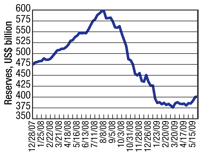Oil and Gas in the Capitals
Why Russia has been hit by the crisis The crisis has hit the Russian economy at last. The GDP fell considerably, by 12.3% in first-quarter 2009, an unprecedented drop since the blackest days of 1992. Of course, this puts Russia back to its 2007 level, which was not bad at all. The drop is not due to the reasons usually given in the Western press, however. Oil prices, which fell precipitously during last fall and winter, have rebounded since February. They are now significantly greater than US$60/bbl, and spent much of June above $70. So, if the oil price slump was so brief, why has the Russian economy now been hit by the crisis? This is seriously placing in doubt the assumption that Russia is another “oil state.” Though energy plays an important role in Russia, it seems the economy is not an energy-centered one. The first reason for the country’s current economic hardship is the liquidity crisis triggered by the Lehman Brothers failure. From 2006 on, the Russian economy has become progressively more dependent to foreign liquidity markets as the Central Bank policy has considerably reduced the ability of its own interbanking market to support the economic expansion. The net debt position of Russian banks more than doubled to $126.2 billion from $58.6 billion between December 2006 and the end of June 2008. This was a significant increase, and even if a large share of the net debt was made of long-term borrowing, the inability to make a rollover after September 2008 significantly destabilized the whole system. The fact that large Russian enterprises have also been heavily indebted added its own weight. This necessitated a large program of state subsidization. Although so far this program has prevented a major failure, it has not led to a rebound of the lending process in Russia. This has had a significant impact on Russian enterprises, which have been unable to fund their turnover operations. The second reason has been the contraction of Russia’s export markets. Russia has been an exporter of metals (ferrous and non-ferrous) as well as some basic chemical products and cellulose. The dependency of the Russian economy on exports was high, with nearly 70% of the steel production being processed for foreign markets. The current slump in the construction sector in Europe has had an extremely strong impact on the metals sector, where production declined by nearly 50%. A similar situation is to be found in the chemical industry, where most products were bound for the construction markets in Europe, too. The slump in exporting industries has had a cumulative impact, as they were those with the highest wages and had a considerable impact on the internal consumption.
However, there is a third reason for the current crisis: the government policy, or more precisely the policy of the Ministry of Finance. The government has not underplayed the seriousness of the situation. This can be shown by the amount of support it committed to the banking sector, as well as to the real economy. However, the combined responses of the Ministry of Finance and the Central Bank have played a very negative role, indeed. First, they have allowed the overvaluation of the ruble since 2006. This had led to a considerable increase of hot money entering Russia, and had seriously destabilized the economy by sharply increasing costs. Then, with the beginning of the liquidity crisis, the hot money flowed away from Russia (see figure) and the ruble fell heavily, but not before the Central Bank tried to curb this fall by increasing its refinancing rate to 13%. Second, the Ministry of Finance was weak in establishing its governance over the lending it did to the bank. This is not an unusual story, by the way, but in Russia it led to a contraction of 20% for enterprise credits and of 26% for personal ones. This compounded the extreme contraction of consumption and day-to-day enterprise activities. Third, the Minister of Finance himself proclaimed his intention to balance the budget, sending the worst possible signal in a time of deep recession. He reversed his stance soon afterward, and the budget deficit was greatly expanded, but funded on the stabilization fund. However, this contributed considerably to downward expectations. There are now some signs of hope in the Russian economy. The stimulus package is slowly having its effect, and the Central Bank is lowering its rates. There is also a rally at the Moscow stock market. However, this is likely to be a mixed blessing because even if it provides funding for Russian enterprises, this rally is also the product of pure speculation, and could be quickly reversed. The ruble is again on the rise, and this is bad news for the Russian economy. With the current recovery of oil prices, the budget deficit is likely to be less important than it was forecast, and will probably not surpass 8%. Also, the Russian government seems finally to understand that too great a dependency on export markets is not an asset but a liability. The crisis of winter 2008–2009 is likely to accelerate a move toward a more diversified economy and a greater reliance on the internal market. This is good news, but it is yet to be confirmed, and the government has to understand, too, that opening up the Russian economy has its limits, particularly when it comes to short-term capital flows. Eleven years ago, Harvard-based economist Dani Rodrick published a famous paper titled “Who needs capital-account convertibility?” Certainly not Russia.
.
|
|||||||||||||||||||




